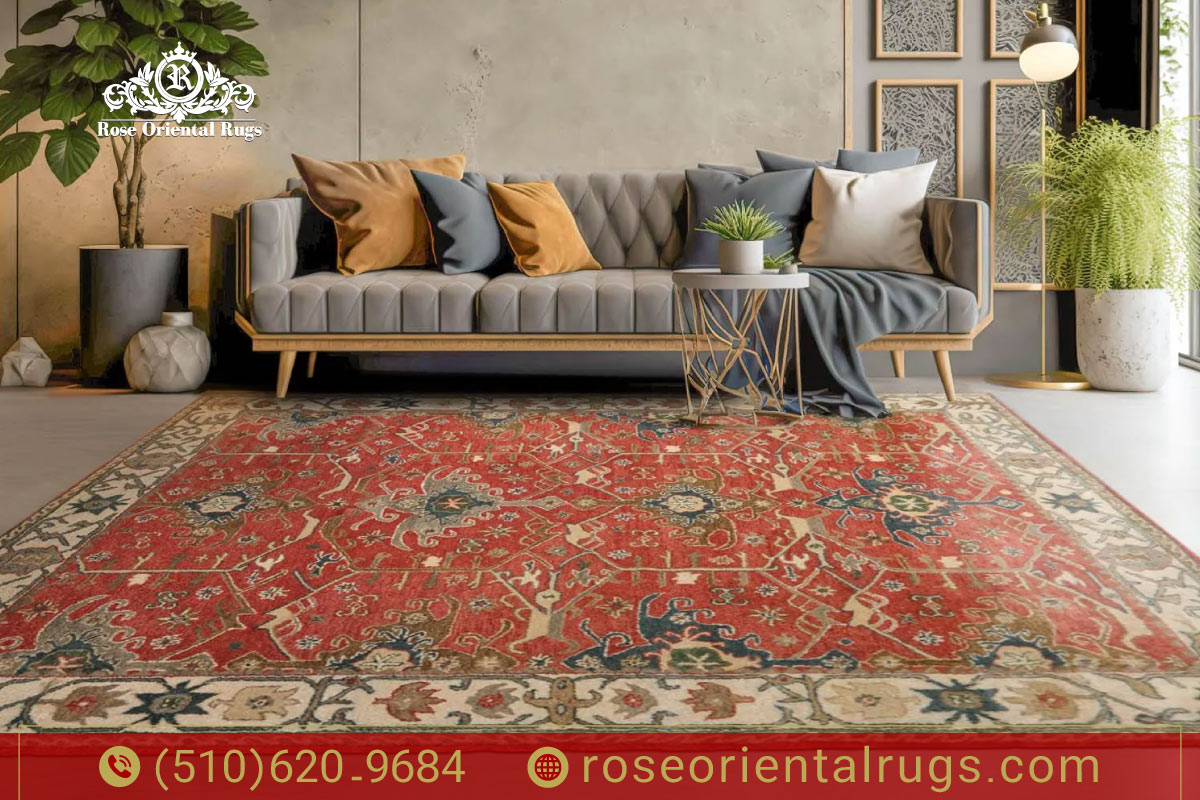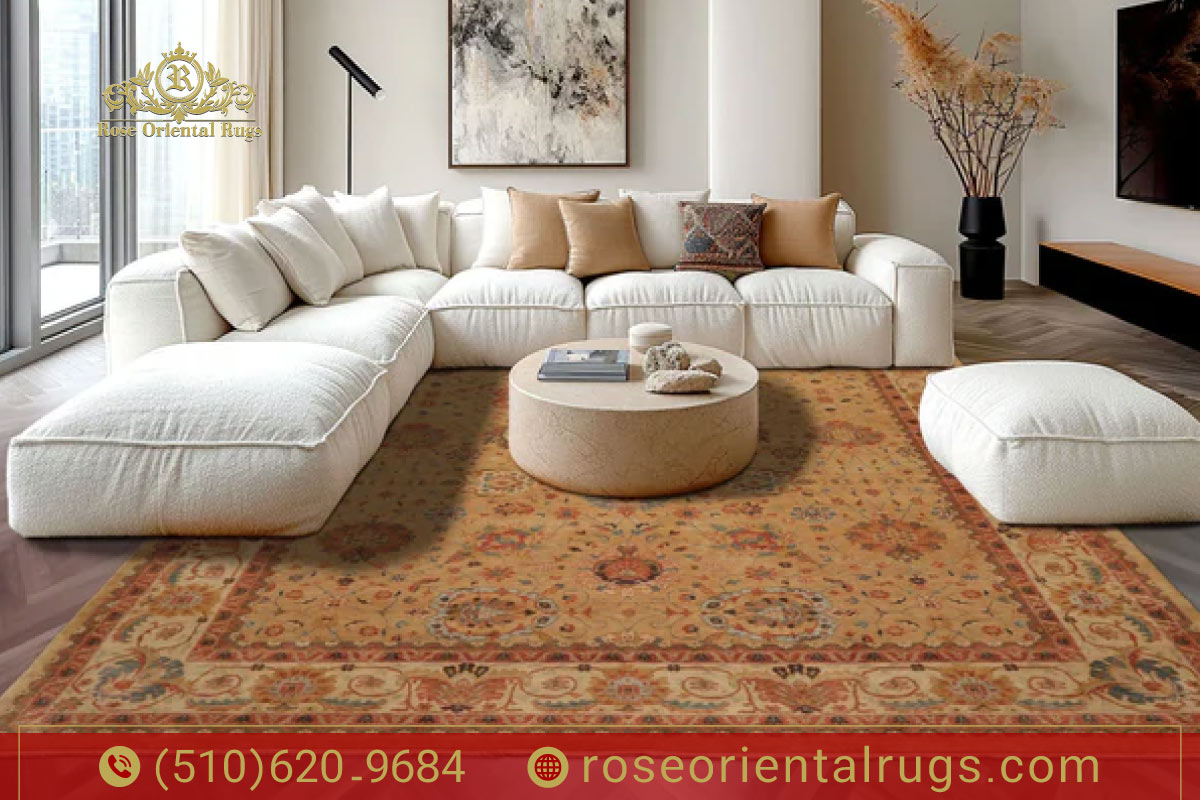Oriental Rug Design Types: A Complete Guide for Collectors

Oriental rug design types are among the most fascinating aspects of interior décor, blending history, culture, and artistry into timeless floor coverings. These rugs are more than functional items; they are pieces of art, each telling a story through their patterns, colors, and weaving traditions.
In this post, we will explore the most popular oriental rug design types, including floral, geometric, medallion, pictorial, tribal, prayer, and modern adaptations. We will also discuss their cultural origins, unique characteristics, and how to choose the right design type for your space, as well as their investment value and where to find a trusted collection.
The Timeless Appeal of Oriental Rug Design Types
The enduring charm of oriental rug design types comes from the way they balance tradition with individuality. No matter if they were made in Iran, Turkey, India, or the Caucasus, all rugs are a testament to centuries-old weaving techniques transferred from one generation to the next. These are extremely time-consuming techniques, with one rug taking months or even years to create, which is why they’re so sought after.
It is the symbolism held in Oriental rug pattern motifs that makes them so distinctive. Numerous motifs are not merely decorative but hold significance in terms of spirituality, good luck, fertility, or protection. For example, the tree of life motif represents immortality and the union of heaven and earth, while floral arabesques symbolize abundance and rebirth. By understanding the various design forms of Oriental rugs, buyers and homeowners can appreciate the craftsmanship and symbolism behind each piece more, making the occasional purchase a richer cultural experience.
Floral Oriental Rug Design Types
Floral oriental designs are among the most refined and versatile, often with delicate garden-inspired motifs like flowers, vines, and leaves. Persian weaving art is particularly renowned for its beautiful, curvilinear patterns, which give rise to rugs that evoke the impression of flowing movement. A rose-filled, tulip-covered, or lotus-blossomed carpet not only beautifies a room but also sends messages of rebirth, romance, and timelessness.
They are particularly priceless since they are adaptable to various interior styles. A dark-colored, flowered rug can be appropriate for an antique-themed room with antiques, while a pastel-colored, light-colored flowered rug can bring warmth to a minimalist modern living room. Orientally styled floral rug designs are works of eternity that bring the elegance of nature inside, and they can be used in casual as well as formal rooms. For those homeowners who want the elegance and harmony look, floral rugs will be the most in-demand option.
Geometric Design Types
Geometric oriental rug design types emphasize symmetry, precision, and bold, striking patterns. Shared motifs include diamond forms, hexagons, octagons, zigzags, and stars, set in balanced compositions. They are most prevalent among Turkish kilims and Caucasian rugs, crafted by tribal weavers who utilized straight-edged, angular tools that incidentally produced straight-edged motifs.
The symbolism of geometric motifs often relates to images of balance, protection, and eternity. Duplicate diamond motifs, for instance, can symbolize an unbroken cycle of existence, while star motifs are usually representative of celestial guidance. Geometric oriental rug design motifs are most attractive to modern interiors because the dominant motifs resonate with the pure lines of new design. In a domestic setting, these rugs can serve as a design statement that adds energy and definition to a space. Collectors also favor geometric rugs since they are unique, restrained, and blend tradition with contemporary tastes.
Medallion Designs
Medallion oriental rug design types are some of the most recognizable in the world of fine carpets. These rugs feature a big, middle pattern, usually round, star, or diamond, that captures the eye’s focus to the middle of the work. The more detailed fields and borders that hold this middle medallion can consist of floral scrolls, arabesques, or other small repeating shapes.
The medallion itself typically symbolizes the cosmos, with its center symbolizing balance and cosmic harmony. This design motif is significant in Persian carpet society, where medallion carpets are symmetrical and crafted masterworks. Medallion Oriental rug design motifs are typically applied in formal areas, such as living rooms, foyers, or dining rooms, where their grandeur can be intimidating. These rugs not only bring aesthetic benefits but also convey a great deal regarding elegance and prestige, making them a suitable option for anyone looking to display class in their home.
Pictorial Oriental Rugs
Pictorial oriental rug design types are unique because they go beyond abstract or symbolic motifs to depict realistic scenes. These rugs may depict landscapes, hunting scenes, royal portraits, or historical events, such as those illustrated in a painted image. Persian and Indian weavers of rugs, for instance, have been able to produce pictorial rugs that are comparable to fine art paintings.
The beauty of pictorial rugs lies in their narrative quality. Not like geometric or floral rugs, which are more patterned, pictorial rugs are narrative. They include pastoral gardens and rivers, or significant cultural or historical events. Collectors love the rugs not only because of their craftsmanship but also because of the insight they give into the artistic imagination of the period. Oriental rug design styles are also hung on walls; therefore, they find their way to galleries or as home decorative art pieces. Such styles are not common, highly detailed, and are typically reserved for investments and home decorating as well.
Tribal Design Types
Tribal oriental rug design types are woven by nomadic and village artisans, giving them a raw, authentic charm. These rugs tend to be boldly geometric in design, featuring stylized animal forms or symbolic figures that have been handed down through families or tribes. They are coarser in design than those made in city Persian workshops, but this is part of their charm.
Every rug is a reflection of the producers’ identity and cultural values. Turkmen rugs, for instance, typically employ octagonal guls as tribal symbols, while Afghan rugs can have animal or weapon patterns, symbolizing protection and strength. The dyes are generally earthy and bright, and are derived from natural sources, including plants, roots, and minerals. Tribal oriental rug patterns add warmth, narrative, and personality to contemporary spaces. As the ultimate rustic, country-scented, natural look for those with an eye for aesthetics, tribal rugs fit the bill.
Prayer Oriental Rug Design Types
Prayer-oriented carpet designs follow primary spiritual meanings and have been historically used during Muslim prayers. These carpets tend to be smaller in size and feature a mihrab, or an arched pattern, indicating the direction of Mecca. Additional symbols such as lamps, trees of life, and flowing water can be found within the arch, representing divine light, everlasting life, and purification.
While they are used most often for prayer, prayer rugs also hold value as works of art. They are cherished by many for the symbolism and personal devotion they represent. Prayer rugs are commonly finely woven and are richly adorned, making them a solid investment for beauty and practical use. Prayer oriental rug styles are some of the most significant forms, combining art and religion in a few ways.

Modern Adaptations of Oriental Rugs
Modern adaptations of oriental rug design types breathe new life into centuries-old traditions. Contemporary rug-makers often reinterpret classic motifs, such as medallions, florals, or geometrics, using updated color palettes, simplified forms, or abstract variations. For example, an ancient Persian medallion can be reimagined in pale blues and grays to complement contemporary minimalist decor.
These innovations appeal to young homeowners who desire the cultural quality of Oriental rugs but not to the extent of overwhelming their modern interiors. They appeal equally to designers who are passionate about blending tradition with modern aesthetics. Contemporary oriental rug design styles see to it that the art of rug weaving is not forgotten and stays relevant to generations to come. To consumers, they are the perfect middle ground between the past and the present taste.
Choosing the Right Oriental Rug Design
Choosing the right oriental rug design types for your home depends on your lifestyle, personal taste, and the function of the room. A flower rug can home the appearance of a respectable living room, and a geometric rug can revitalize a modern loft. Medallion rugs best complement luxury dining rooms, whereas tribal rugs add warmth and authenticity to informal rooms. For those interested in story or symbolic value, pictorial and prayer rugs add beauty as well as cultural richness.
It’s also important to look at practical considerations, including rug size, material, maintenance level, and rug cleaning services, for example if you live in Berkeley, Rose oriental rugs cleaning services in Berkeleyhttps://roseorientalrugs.com/rug-cleaning-in-berkeley/ is perfect for you . Wool rugs are durable and repel dirt, while silk rugs are fragile and ideal for low-traffic spaces. Through careful research of your needs and knowledge of the symbolism involved in oriental rug design categories, you can find a rug that is appropriate for your home and you.
The Investment Value of Oriental Rugs
Oriental rug design types are not just beautiful; They can even be a sound long-term investment. Hand-knotted rugs made well with good-quality wool or silk and natural dyes are guaranteed to appreciate over the decades, particularly those with rare patterns or coming from a respected weaving area. Investors also view oriental rugs as a tangible asset, like artwork or antiques, which would last for centuries.
The worth of oriental rug style types also varies based on condition and provenance. The rugs that are in the best condition, have historical precedence, or are otherwise rare in their designs can sell for record prices at auction. For homeowners, this means that buying a rug is both a design choice and an investment choice. A truly exceptional carpet can be both a practical household item and a family treasured heirloom.
Conclusion
Oriental rug design types reflect centuries of artistry, cultural heritage, and human expression. From placid Persian garden flowers to the rugged geometries of Turkish art, each design has a tale to tell. Medallion, pictorial, tribal, and prayer rugs also bear witness to this diversity and symbolic richness of these works. Present-day reinterpretations sustain the tradition and hence remain pertinent today.
To collectors, homeowners, and designers, oriental rug patterns are not only beautiful but also significant. They are not merely a decorative item but a piece of history that can add class to every household. Suppose you want to have an excellent source of high-quality rugs. In that case, Rose Oriental Rugs in Berkeley is an excellent selection of various Oriental rugs with diverse designs, including traditional and modern styles, to suit everyone’s taste.

